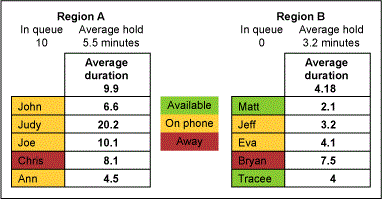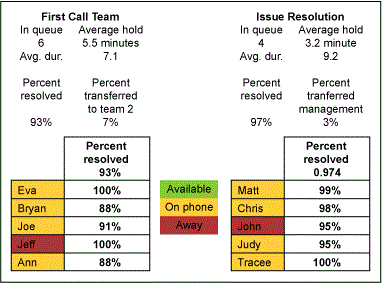
In the 1990s, the teller counter was the primary customer-facing area in the financial service industry, and so improvement efforts were leveraged in this arena. With increased improvements in technology and online banking utilization, however, process improvement efforts have shifted to internal areas.
Yet companies must realize that even though customers are becoming more self-reliant through the use of technology, they still need assistance from time to time, which has led to an increased volume in call centers. Within these call centers, there may be no bigger improvement opportunity than the agent call-handling process. In most cases, this is the only interaction the customer has with a company and they expect superior delivery in answering their questions and resolving their issues.
Making Call Center Improvements
I had the opportunity to work on business process improvement efforts with a call center. The call center employees were feeling a great deal of stress due to expected response times and resolution on customer inquiries or complaints. Management collected a lot of data regarding hold times, the number of representatives available to answer calls and average call length. To improve these measures, management posted live updates on a board to promote a little competition (Figure 1).

The competition motivation worked. Call agents did their best to answer calls and get the customer off the phone as fast as they could. Hold times and call duration were dramatically decreased. The drawback was that many of the customer calls were ended without resolutions. One of the key customer satisfaction areas was resolution on inquiries or complaints. In addition, call volumes began to increase dramatically. Practitioners eventually were able to conclude that often the same caller was calling back multiple times because their issue had never been resolved, thus increasing call volume. The call center manager was planning to “react” to this by hiring more staff, reallocating staff from Region B to Region A, and forcing staff to be on the phone more.
Through validating existing processes, measurements and controls, practitioners were finally able to determine that they were not collecting data relative to the company goals of resolving 85 percent of the inquiries the first time around (first-call resolution) and 90 percent of inquiries within three days (three-day resolution). In addition, they gathered data on the callers who were unable to get answers to their questions. The team then incorporated Lean and Six Sigma to focus on the goals associated with improving performance.
Call Center DMAIC Findings
Defining the customer, their critical to quality (CTQ) issues and the core business process involved:
- Defining who the customers are, what their requirements are for products and services, and what their expectations are.
- Defining project boundaries, including the stop and start of the process.
- Defining the process to be improved by mapping the process flow.
Common sense dictated that call center agents must be available to answer calls to keep hold times down; however, voice-of-the-customer (VOC) data revealed that providing issue resolution or answering questions was, by far, more important than hold time. Although Region A and Region B utilized the same process, process maps for both regions were created in hopes of finding a quick win, given that the data collected showed Region B outperformed Region A. Early analysis proved this was merely due to call volume because Region A serviced more heavily populated areas.
Measuring the performance of the core business process involved:
- Developing a data collection plan for the process.
- Collecting data from many sources to determine types of defects and metrics.
- Comparing performance to customer survey results to determine shortfall.
Baseline performance had previously been gathered on hold, call abandonment and duration times. With the new knowledge and emphasis placed on call resolution time, practitioners established the following baselines: First-call resolution = 35 percent and three-day resolution = 45 percent. Upper specification limits were validated and communicated. In preparation for Analyze, the team gathered additional metrics, including call volume and cost per call. This data was stratified by region, employee, month, time of day, number of callers who never received an answer, and number of callers who had to make multiple calls for the same issue or question.
While Analyzing the data collected and the process map to determine root causes of defects and opportunities for improvement, practitioners:
- Identified gaps between current performance and goal performance.
- Prioritized opportunities to improve.
- Identified sources of variation.
During the Analyze phase, practitioners learned:
- The call center had 30 agents, divided between two regions, handling different call types. Although they followed the same procedures, there was variation across all 30 agents – each agent did things differently. There was also variability within the agents themselves because many handled the same call type differently each time. Thus, the call center did not have one process to improve – it had hundreds, just for one simple call type.
- Although all agents were thought to handle multiple call types, certain agents were more proficient at or enjoyed certain call types more than others. Internally, agents were directing specific types of calls to people within their region. The key finding was that there was, in fact, a need for cross-training.
- Most of the calls could not be resolved to the customer’s satisfaction on the first call and required additional research or escalation to Tier 2 and 3 representatives.
- Call center agents were evaluated on their availability to answer the phones, not answering the questions. Obviously, this decreased the time they could devote to research open issues. The outcome was that most calls that could not be resolved right away often were never resolved.
- Customers whose inquiries were not answered within a few days would call back. This increased the call volume, inflated the number of calls that could not be resolved on the first call and led to multiple entries in the data-tracking application for the same inquiry.
Improving the target process by designing creative solutions to fix and prevent problems involved:
- Creating innovate solutions using technology and discipline.
- Developing and deploying an implementation plan.
In order to achieve company goals, the following solutions were agreed upon:
- Divide the team into separate functions: answering the call and resolving the issues
- Rotate call center agents between the separate functions in order to transfer knowledge
- Assign any calls that were not resolved within two days to management for action
To reduce variation, call center representatives needed to have a process to follow (standard operating procedures). The representatives should follow that exact process because it allows them to deliver quality service and because it makes their work life easier.
However, standardizing the process did not mean the process was optimized. Practitioners eliminated several kinds of waste in the call center: waste from having the product or people waiting around, waste from excessive steps or movement, and waste from rework.
Controlling the improvements to keep the process on the new course involved:
- Preventing representatives from reverting back to the “old way.”
- Requiring the development, documentation and implementation of an ongoing monitoring plan.
- Institutionalizing the improvements through the modification of systems and structures (staffing, training and incentives).
In less than eight weeks, baseline goals rose from 35 percent for first-call resolution to 93 percent and from 45 percent for three-day resolution to 97 percent. In addition, calls that never received an answer were all but eliminated. Figure 2 provides an example of the revised scoreboard displayed for call agents to better monitor progress toward goals.

The benefits of applying Lean and Six Sigma process improvement methodologies to call center processes can be rewarding. Needless to say, customer delight rose significantly. There have been many developments since the improvement effort was orchestrated. New software, for example, provides the ability to respond to the customer immediately after the call, to collect online and instantaneous customer feedback, and to gain a current measure of customer delight instead of waiting until the next survey. This provides for continuous improvements in the call agent handling process and enables ongoing application of Lean principles that will produce breakthrough results for employees, customers and shareholders.